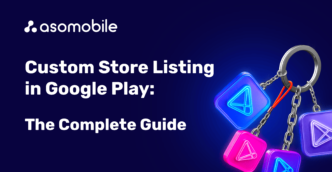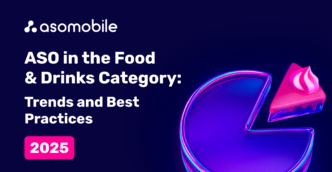ASO App Optimization Checklist for Google Play and App Store
The short ASO Checklist for Google Play and App Store.
Once upon a time, the App Store and Google Play created a unique niche:
- for themselves
- for app developers
- for users
Under such conditions, the emergence of ASO was natural. Because everyone needs ASO: stores to rank applications better, developers to create a more successful product from the start, and users to search for the app more productively. ASO is beneficial and required by everyone.
But ASO optimization is very, very extensive. Where to start, how to approach, and how to make your application more visible to the end-user? The list of questions can go on and on, so we have prepared for you an informative guide with ASO checklists for the App Store and Google Play.
Let's start by answering the question - why is ASO for the App Store different from Google Play?
ASO optimization for both stores not only can but must be different. Despite the common goals and purpose of the App Store and Google Play, they have a number of significant differences and characteristic features. Here are the main ones:
- metadata (visibility of certain elements to the user, different number of characters available, ranking algorithms)
- ranking factors (for example, taking into account external links, the presence of a keywords field)
- search algorithms (for the App Store it is not necessary to duplicate the title+subtitle+keywords keywords, and for Google Play it is necessary to distribute and repeat keywords throughout the metadata array, the main thing is not to forget about overspam)
- user interests (the top 10 in terms of downloads of applications from stores differ significantly)
- locale (Google Play has one country = one localization, the App Store has more room to maneuver)
- technical requirements (visual range)


Both the App Store and Google Play have a wide range of tools and application points for ASO, the main thing to remember is that indexing mechanisms vary among stores, so ASO strategies should be individual for each store.
That is why we have prepared two separate checklists. Let's get started.
At the end of the article, you can find a 40% discount coupon for the first month of using ASOMobile - a tool for creating ASO and researching competitors in the mobile app market.
ASO optimization checklist for the App Store
- TITLE (application name) - indexed.
You have 30 characters and the fact that the app name has the most ranking weight. Therefore, relevant keywords should also be placed in the allotted 30 characters, and make sure that the title speaks about the functionality of the application, conveys its essence, and “advertises” its capabilities to the consumer.
So the title should be:
- simple
- easy to remember
- harmoniously “look” with the icon
- contain relevant keywords
NB: Use the maximum of all available 30 characters. This advice is relevant for all available fields and not only on the App Store.
- SUBTITLE - indexed.
Here 30 characters are also allotted. It is indexed less than Title, but visible to the user. Add priority key phrases here - this will increase your position in the search results.
NB: Do not duplicate keywords from the application name here. The App Store algorithm still won't index duplicate words. On the contrary, enter additional relevant keys in this field, and expand the search results of your application.
- KEYWORDS - indexed.
There are 100 characters given including commas. Text separately, separated by commas, without spaces.
It should have:
- relevant keys
- do not duplicate keywords from Title and Subtitle
- do not repeat keys within the Keywords field itself
NB: pay attention to locales. Consider the country where the application is located and use the possibilities of additional localizations.
- PROMO TEXT (short description) - not indexed.
There are 170 characters allotted. An excellent opportunity to describe the benefits, features, and other goodies of the app.
- APP DESCRIPTION - not indexed.
Up to 4000 characters. Despite the lack of indexing, it should be used as a strong marketing tool. Describe the app here in a way that makes users want to install it. Do not neglect the possibility of as many as 4000 characters. Let the description call the user to the desired action.
- Additional points that affect the app ranking, and hence additional points of control:
- Localization
The possibility of one or more additional locales other than the primary must be used. Consider the language differences and the difference in mentality for competent optimization of the application in different countries.
- Settings
Everything is simple here, the more installations, the higher the application ranks in the store, which means that with each installation the application becomes more visible to the next users.
- Profitability
Applies to paid apps only. There is a direct correlation here, the more income the application brings to the store, the higher it is ranked by the App Store itself.
- Ratings and reviews
The average app rating is important. It is directly proportional - the higher the score, the higher the position of the application in the rating of the store. Reviews do not count towards app promotion.
NB: You can reset the average app rating after updates are released. But it should be remembered that reviews do not disappear anywhere and users see all the reviews for the entire period of the application's existence. Be careful.
- Updates
An app that is updated regularly is more liked by the store. Because such an application offers users a higher quality product and the App Store gives an updated application in search results more often and higher. By the way, the reviews mentioned above will help you understand when it is worth updating the application, to fix bugs and expand functionality.
Do not neglect seasonal updates and themed holidays.
When releasing an update, do not be too lazy to describe in detail the corrected points. The App Store values detail and openness. Don't neglect it.
ASO optimization checklist for Google Play
- TITLE (application name) - indexed.
Until 2021, Google Play allowed 50 characters, now there are 30 ones given.
What you should pay attention to:
the name should help the user understand what the app is about
- the title should reveal the functionality of the application
- relevant keywords are required
- simplicity and ease of remembering the name
- the name and the icon should match, and be complementary to each other
NB: Don't use an emoji, Caps Lock, unless it's an abbreviation, acronym, or recognizable brand name. And yet, the words “free”, and “best” will not add indexing to the application, so it is better to refrain from such “improvers” of the name.
- SUBTITLE is not provided.
- KEYWORDS are not provided.
- PROMO TEXT (short description) - indexed.
80 characters. Don't forget to use keywords here. And remember, no emoji.
- APP DESCRIPTION - indexed.
Excellent 4000 character indexing capability:
- be sure to add important keywords
- write significant words and phrases several times
- strengthen the keys, and repeat them from the short promo text. But don't forget about overspam. Follow the rule - three keys in different occurrences or one key per 250 characters
- the description should be informative, honest, correctly reveal the functionality of the application and, to the maximum, interest the user
NB: the keys in the first lines are more relevant than the descriptions below them in the text.
- Other nuances related to the ranking of the application that you should control:
- Settings
The more often an app is installed, the more popular it is. The more popular it is, the higher it ranks in the store. The higher it is ranked by the store, the more noticeable it is for users and the higher the number of installs.
- Revenue
Applies to paid apps only. The more often the application is installed, the higher and more stable the income of the store. The store ranks the app higher in gratitude. Mutually beneficial process.
- Removal
If the app is installed, that's good, but if it's installed and uninstalled, that's bad. A high number of deletions triggers the store algorithm to downgrade the positions of the app.
- Rating and reviews
Both the average rating of the application and user reviews about it work here. The higher these indicators, the higher the rating of the application.
NB: Reviews are indexed by the store. It follows that reviews can be used as a field for additional indexing by inserting keywords directly into reviews. Be careful, the meaning of the review should be clear and remember about overspam.
- Updates
Here are the basic steps to increase indexing:
- Regular updates are important. Use seasonal holidays, for example, release themed updates
- read reviews, they will help you to fix bugs and improve functionality in a timely manner, focus on users
- write a detailed description of the update. This instills confidence in the store
We have included in these checklists the most significant factors by which the app is indexed and which should be monitored for timely adjustment of the ASO rate.
You are welcome and may your ASO strategy always be successful!
 Українська
Українська  Русский
Русский  Español
Español 






